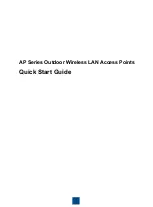
2
Copyright © 2013 ADTRAN, Inc. All Rights Reserved.
Quick Start Guide, 61700954F1-13B, February 2013
3
with the T-rail mounting hardware kit to increase the space between the unit and the mounting
bracket. Leave enough of the long screws exposed above the spacer to ensure they can be
inserted into the keyed slots on the mounting bracket.
6. Mount the BSAP on the mounting bracket by inserting the screws on the back of the BSAP into the
keyed slots on the mounting bracket and rotating the unit clockwise 90 degrees to secure it on the
bracket.
7. Optionally, protect your BSAP with a Kensington cable lock (not provided) inserted into the security
slot.
M
OUNTING THE
BSAP
TO A
D
ROPPED
C
EILING
The BSAP 1920/1925 ships with a T-rail mounting kit to mount the BSAP on the ceiling tile separators of
standard dropped ceilings. The mounting clips come in two sizes and can be mounted to either
recessed (using the spacer) or flush dropped ceiling T-rails. BSAPs should be positioned for maximum
throughput and range between other APs and wireless client devices.
To mount the BSAP to a dropped ceiling:
1. BSAP 1925 only: Install the antennas (sold separately) onto the appropriate antenna ports on the
BSAP. The antenna ports are labeled
2.4G
and
5G
.
2. Attach the appropriate size ceiling clips to the bottom cover of the BSAP using the provided short
screws.
If extra space is required to accommodate recessed dropped ceiling tiles, use
the provided spacers and longer screws included in the T-rail ceiling mount
kit.
Wall or Ceiling
BSAP 1925 with
Antennas Mounted
Screw Anchor
Plastic Mounting
Bracket
Keyed Slots
Short Screws
Mounting Screw
Receptacles
Long Screws
BSAP 1920
Keyed Slots
Short Screw
Long Screws
T-rail Ceiling Clips
Spacers
Mounting Screw
Receptacles
Short Screws
T-rail Ceiling Clips
Mounting Screw
Receptacles
3. Once the ceiling clips are attached to the BSAP, line up the T-rail clips with an appropriately sized
rail and press the unit onto the rail until it snaps into place.
4. Optionally, protect your BSAP with a Kensington cable lock (not provided) inserted in the security
slot.
S
UPPLYING
P
OWER TO THE
BSAP
The BSAP 1920/1925 does not have a power switch. It is powered when connected to a network device
that supplies PoE based on the IEEE 802.3af standard, an optional external PoE injector
(P/N 1700923F1), or by an optional external DC power adapter (P/N 1700928F1) connected to an AC
power source. Although the BSAP 1920/1925 is fully functional using 802.3af PoE, it also supports
802.3at. To use the external DC power adapter, connect the adapter to the
12V DC
port on the back of
the unit. The DC power adapter automatically adjusts to any voltage between 100 and 240 VAC at 50 or
60 Hz. No voltage range settings are required.
C
ONNECTING TO THE
BSAP
If the BSAP is to be powered using a network device such as a switch, connect the Ethernet port of the
BSAP to the appropriate switchport. Obtain the IP address of the BSAP from the Dynamic Host Control
Protocol (DHCP) server (based on the MAC address of the BSAP). DHCP is enabled by default. You
can then use a Secure Shell (SSH) client to connect to the BSAP based on the instructions below.
If the BSAP is powered using a PoE injector, connect the Ethernet port of the BSAP to the
OUT
port of
the PoE injector and connect the Ethernet port of the computer to the
IN
port on the PoE injector. Then
proceed to SSH to the default IP address of the BSAP as instructed below.
If the BSAP is powered using the optional DC power adapter, connect the Ethernet port of the BSAP to
the Ethernet port of the computer. Then proceed to SSH to the default IP address of the BSAP as
instructed below.
C
ONFIGURING THE
BSAP
WITH V
WLAN
AND
AP D
ISCOVERY
The BSAP 1920/1925 can be configured for use with the Bluesocket virtual wireless local area network
(vWLAN). If you have installed vWLAN, and want to use AP discovery to configure the BSAP, follow
these steps:
1. After powering the BSAP and connecting it to the network, allow the BSAP to discover the vWLAN
appliance to receive its configuration information. This AP discovery process uses an algorithm that
attempts discovery methods in this order: static configuration, Dynamic Host Control Protocol
(DHCP) vendor option (43), Domain Naming System (DNS) discovery, and cached vWLAN
information. If no response to the discovery request is received, the algorithm moves to the next
method in the list (except when using static configuration, which never queries the other discovery
methods).
2. There are two additional network components that can be configured to facilitate AP discovery.
First, an external DHCP server can be configured to assign IP addresses to APs associated with
the vWLAN. When configuring the DHCP server, make sure to configure the Bluesocket DHCP
Vendor option (
43
) on the server. Second, you can configure an external DNS server to resolve the
name
apdiscovery
to the IP address of the vWLAN instance in the network environment.
If the BSAP is used in a medical environment, it must use an
IEC/EN 60601-1 compliant power adapter.






















